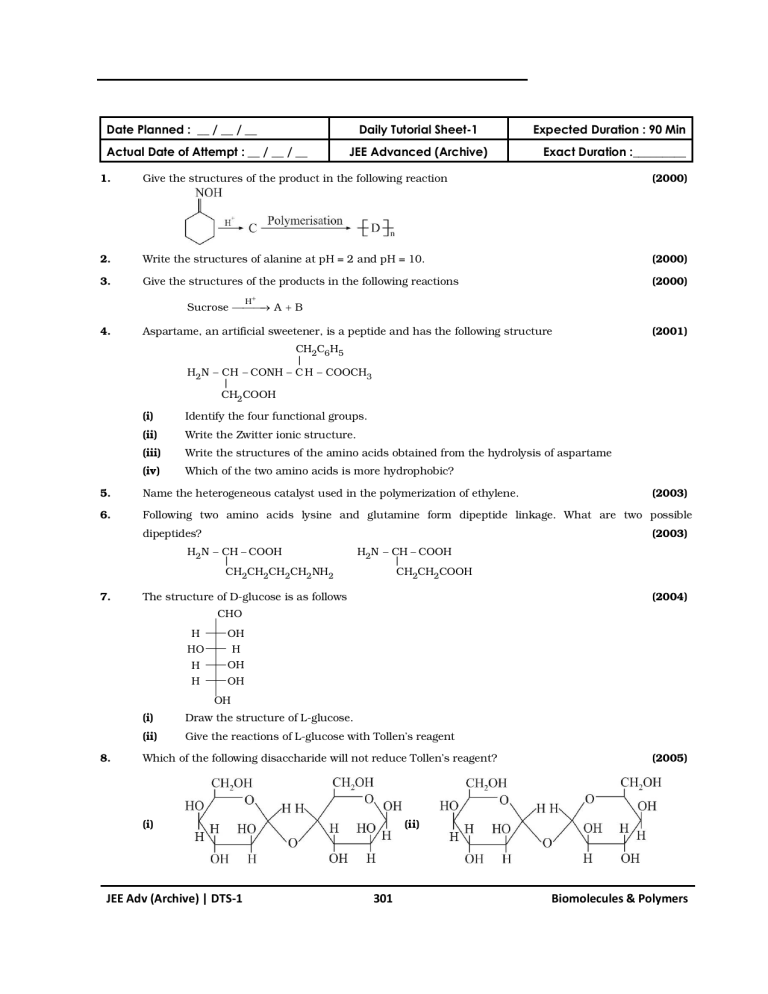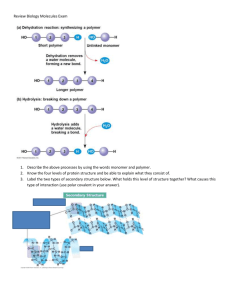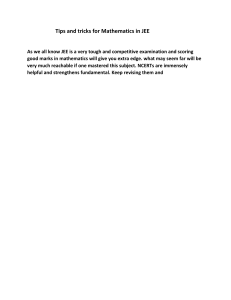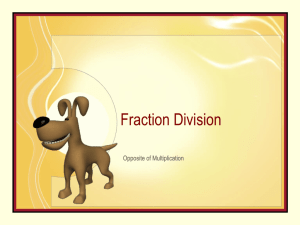
Date Planned : __ / __ / __ Actual Date of Attempt : __ / __ / __ Daily Tutorial Sheet-1 JEE Advanced (Archive) Expected Duration : 90 Min Exact Duration :_________ 1. Give the structures of the product in the following reaction (2000) 2. Write the structures of alanine at pH = 2 and pH = 10. (2000) 3. Give the structures of the products in the following reactions (2000) H Sucrose A B 4. Aspartame, an artificial sweetener, is a peptide and has the following structure (2001) CH2C6H5 | H2 N CH CONH C H COOCH3 | CH2COOH (i) Identify the four functional groups. (ii) Write the Zwitter ionic structure. (iii) Write the structures of the amino acids obtained from the hydrolysis of aspartame (iv) Which of the two amino acids is more hydrophobic? 5. Name the heterogeneous catalyst used in the polymerization of ethylene. 6. Following two amino acids lysine and glutamine form dipeptide linkage. What are two possible (2003) dipeptides? H2 N CH COOH | CH2CH2CH2CH2 NH2 7. (2003) H2N CH COOH | CH2CH2COOH (2004) The structure of D-glucose is as follows CHO H HO H H OH H OH OH OH 8. (i) Draw the structure of L-glucose. (ii) Give the reactions of L-glucose with Tollen’s reagent Which of the following disaccharide will not reduce Tollen’s reagent? (i) JEE Adv (Archive) | DTS-1 (2005) (ii) 301 Biomolecules & Polymers *9. (2006) For ‘invert sugar’, the correct statement(s) is(are) : (Given: specific rotations of (+) –sucrose, (+) –maltose, L-(–)-glucose and L-(+)-fructose in aqueous solution are +66°, + 140°, –52° and + 92°, respectively) 10. (A) ‘invert sugar’ is prepared by acid catalyzed hydrolysis of maltose (B) ‘invert sugar’ is an equimolar mixture of D-(+)-glucose and D-(–)-fructose (C) specific rotation of ‘invert sugar’ is 20 (D) on reaction with Br2 water, ‘invert sugar’ forms saccharic acid as one of the products Statement-1 : Glucose gives a reddish-brown precipitate with Fehling’s solution. (2007) Statement-2 : Reaction of glucose with Fehling’s solution give CuO and gluconic acid. (A) Statement-I is correct; Statement-II is correct; Statement-II is a correct explanation of Statement-I (B) Statement-I is correct; Statement-II is correct; Statement-II is not the correct explanation of Statement-I (C) 11. Statement-I is correct; Statement-II is incorrect (D) Statement-I is incorrect; Statement-II is correct Match the chemical substances in Column I with type of polymers/type of bond in Column II. Column-I 12. (2007) Column-II (a) Cellulose (p) Natural polymer (b) Nylon-66 (q) Synthetic polymer (c) Protein (r) Amide linkage (d) Sucrose (s) Glycoside linkage Among cellulose, polyvinyl chloride, nylon and natural rubber, the polymer in which the intermolecular (2009) force of attraction is weakest is : (A) nylon (B) poly(vinyl chloride) (C) cellulose (D) natural rubber 13. The total number of basic groups in the following form of lysine is (2010) 14. The correct statement about the following disaccharide is : (2010) *15. (A) Ring (a) is pyranose with glycosidic link (B) Ring (a) is furanose with glycosidic link (C) Ring (b) is furanose with glycosidic link (D) Ring (b) is pyranose with glycosidic link The correct functional group X and the reagent Y in the following schemes are : (A) X COOCH3 ; Y H 2 / Ni / Heat (B) X CONH 2 , Y H2 / Ni / Heat (C) X CONH2 ; Y Br 2 / NaOH (D) X CN ; Y H 2 / Ni / Heat JEE Adv (Archive) | DTS-1 302 (2011) Biomolecules & Polymers



